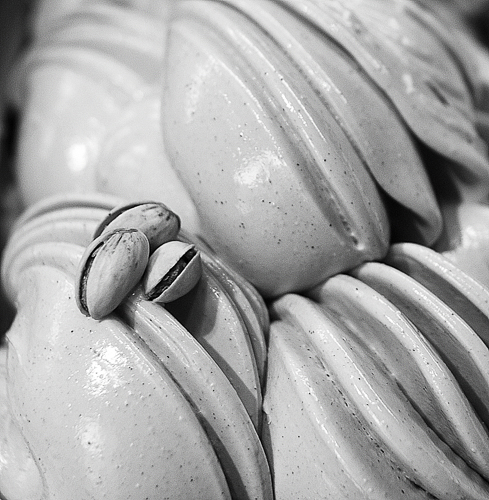We went to visit an ice cream bar called Cocco Verde or the Green Coconut in Falconara Marittima, a town situated north of Ancona at the Adriatic coast. It was founded in 2007 by Riccardo De Simone.
Like any Italian ice cream bar, it had a wide selection of colourful ice creams like strawberry, hazel nut and pistachio. In addition, they had various tiny ice cream cones and rows of small, geometrically shaped containers filled with ice cream with a tiny biscuit or chocolate on top.
We were met by the owner Riccardo who showed us around his ice cream bar, and Micaela, a hard-working, extremely dexterous woman. While he was talking about ice cream and how they made it, she was busy preparing a mixture of milk and sugar together with powdered milk. Following a recipe, she weighed or measured the correct amount of each ingredient before putting them in a container. Finally, she used a mixer in order to obtain a homogeneous mixture. Then she poured it into an ice cream maker, where it would be raised to a temperature of 85°C in order to pasteurize the milk. Afterwards, the same machine would subject it to -10°C .
The mixture has to be subjected to a temperature of 85°C in order to make it secure for human consumption and to make an optimum bond between the solids and the water in the mixture resulting in a more stable structure and a more creamy weaving in the finished product.
The next phase transforms the mixture into ice cream by means of the cold, applying air and churning it continuously.
In fact, Riccardo told us that the fundamentals of making ice cream by hand is the mixture of air, water and sugar. In order to make the ice cream in the trays look palatable, they had used trial and error. During our visit we could see for ourselves fresh ice cream exiting from the machine and entering a bowl.
We learnt that hand-made ice cream is characterised by the use of prime and fresh materials. Comparing industrially made ice cream with hand-made ice cream the following numbers apply: 6-10% fats in ice creams made manually, 8-12 % fats in industrially made ones, maximum 35 % air in hand-made ice cream, while minimum 70 % in industrially made ones. Real hand-made ice cream contains a large amount of milk, at least 60 %, followed by 14–24 % sugar, and 5-20% cream. However, this ice cream bar doesn’t use cream.
During our visit Micaela also made a cone with a small hole at the pointed end. Then, she filled the cone with ice cream before applying it evenly to a set of small plastic containers, cutting chocolate in straight lines using only a knife, making small structures consisting of chocolate which she put on top of some of the ice creams, cutting up the peel of oranges in geometrical shapes which she used for embellishing some of the ice creams, pouring nuts and honey on an ice cream cake. In short, she made their products look delicious.
Presence of ice crystals is okay as long as their numbers are kept at a fairly low level. Negative characteristics include sandiness, that is, the ice cream looks like sand, and it’s caused by an inaccurate amount of powdered milk being applied to the mixture before heating and cooling. We were also told that a well-made ice cream should look smooth, which really wasn’t a surprise.

